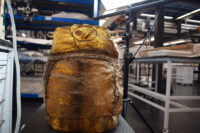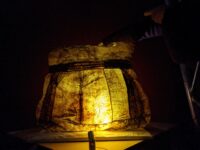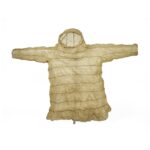 A new exhibition dedicated to the culture of Arctic peoples opened at the British Museum last week. Ancient artifacts are on display next to modern adaptations, emphasizing how inventively indigenous communities around the Arctic interacted with their harsh environments. Objects in the exhibition include an paper-thin translucent parka made from seal guts, a harpoon with an animal bladder float and an incredible bag made out of duck feet.
A new exhibition dedicated to the culture of Arctic peoples opened at the British Museum last week. Ancient artifacts are on display next to modern adaptations, emphasizing how inventively indigenous communities around the Arctic interacted with their harsh environments. Objects in the exhibition include an paper-thin translucent parka made from seal guts, a harpoon with an animal bladder float and an incredible bag made out of duck feet.
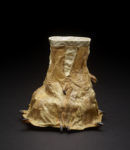 Also on display are a variety of pieces made from fish skin: mittens, shoes, a sewing kit. It is obviously a very hardy material for cold, watery climes, and is so flexible it can be utilized in many ways. Two fish skin bags made by the Yup’ik of southwestern Alaska in the 19th century drew the attention of British Museum conservators, both because of the complexity of materials and construction and because they needed treatment.
Also on display are a variety of pieces made from fish skin: mittens, shoes, a sewing kit. It is obviously a very hardy material for cold, watery climes, and is so flexible it can be utilized in many ways. Two fish skin bags made by the Yup’ik of southwestern Alaska in the 19th century drew the attention of British Museum conservators, both because of the complexity of materials and construction and because they needed treatment.
On both bags, the scaly sides of the skins are mostly facing outwards. However, where there are bleached (white) or dyed skins (red), the skins are turned inwards so that the scales are on the inside of the bag and the softer smoother skin underneath is exposed. What is great is that it is still possible to see the form of the fish, as there are areas where the fin has been removed and the resulting small hole delicately stitched closed. Most of the seam stitching on the bags is done with sinew – a strong fibre made from tendons or ligaments, possibly of beluga whale or caribou (reindeer) – but you can also see white decorative stitching on both bags, which is believed to be caribou throat hair.
On the smaller bag, there are also small strips of white decoration. This is likely to be bleached seal throat, or oesophagus, often used to decorate objects. In wintertime, the oesophagi of seals would be cut from the stomach, inflated and left to freeze-dry outside in the cold, which would turn them very white. These freeze-dried oesophagi are called nerutet in Yup’ik.
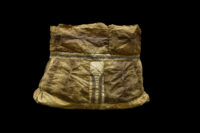 In order to repair tears and weak spots, Organics Conservator Sophie Louise Rowe went to Sweden to learn more about how fish skin leather is made. Armed with expert knowledge on the material, she was able to repair multiple tears in the larger of the two bags, bring back its original suppleness in a humid chamber and stitching together the tears with tiny tabs of Japanese tissue.
In order to repair tears and weak spots, Organics Conservator Sophie Louise Rowe went to Sweden to learn more about how fish skin leather is made. Armed with expert knowledge on the material, she was able to repair multiple tears in the larger of the two bags, bring back its original suppleness in a humid chamber and stitching together the tears with tiny tabs of Japanese tissue.
The smaller of the bags was in better condition with fewer and smaller tears and creases. It posed another challenge, however, because curators wanted to light it from within for the exhibition to highlight the amazing translucency of the fish skin. The Japanese tissue used in the repair was opaque when backlit, which ruined the effect. Enter the ox intestine.
In the end, a repair was carried out using a material called ’Goldbeaters skin’, which is actually processed intestine, traditionally from an Ox. This might sound like an odd choice, but Goldbeaters skin is often used to repair parchment, so is a tried and tested method. The real benefit is that the material is transparent and very thin, so light passes through it well and repairs appear almost invisible.
The British Museum conservators give much credit to the Smithsonian Arctic Studies Center’s YouTube Channel which is dedicated to sharing traditional crafts and languages. It has a fantastic 10-video series on the different ways to sew salmon skin.
